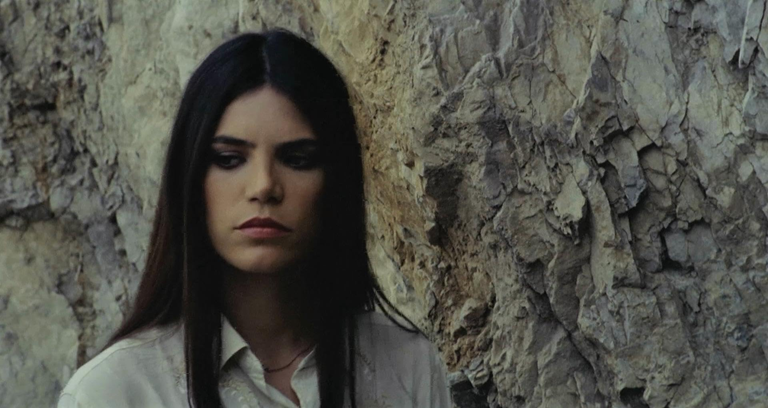Back in July 2020 I burned through watching around ten or so giallo films over a couple of weeks, resurrecting my interest from years prior. A week ago I had a similar urge but this time to watch some 1950s/60s gothic horror–castles, curses, brooding women–and wanted to find movies in Italian with subtitles in order to get better listening and hopefully understanding. Some words and phrases will be less useful (i vizi morbosi, il mulino, lei è un strega) but there will otherwise be simpler dialog that uses probably 50% of my current vocabulary, and maybe repetition will help me pick up new words and provide examples of simple conversational phrases in context.
As I was searching for films to watch I found a Reddit thread where someone mentioned that the Tubi category Italian Horror & Giallo was recently added. Score. Well, not score because they don’t specify which are subtitled and which are dubbed. My “continue watching” pages is a wasteland of films I would start and jump ahead to what appeared to be the first spoken lines, only to see a mumble of English over misaligned mouth movements. (Weirdly, the opposite is also sometimes true where the actor speaks English but is dubbed in Italian. This happens when English-speaking actors are hired ((Karl Malden and James Franciscus in Argento’s Il gatto a nove code and Boris Karloff in I tre volti della paura)). I noticed this because at times I could almost lip read the actors based on the subtitles.) Sometimes the titles don’t even match the spoken language, that is: Italian title with English dubbing or English title with original Italian. Anyway, Tubi’s gotta fix that shit.

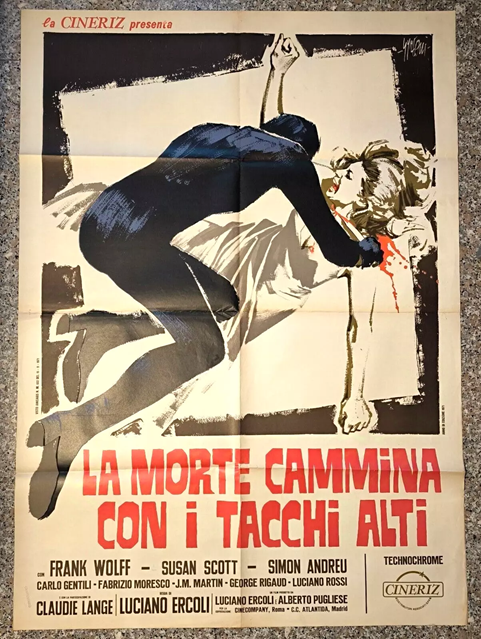

I’m tempted to start collecting giallo posters. The ones I’ve found that interest me (above: a rare advance poster for La morte accarezza a mezzanotte and La morte cammina con i tacchi alti ((both by Luciano Ercoli and with Nieves Navarro and Simon Andreu)), and Lo strano vizio della Signora Wardh ((one of, from what I remember, Sergio Martino’s best movies))), but they are 2-fogli and so are a little larger than what would fit on our walls. Though with the number of paintings and posters nothing fits anymore.
[ed. just made an offer for the accarezza print, we’ll see]
My movie festival so far (15, in order of release year):
Il mulino delle donne di pietra (1960) [ ★★★☆☆ | IMDB | Wikipedia ] – Giorgio Ferroni. Also directed La notte dei diavoli 12 years later in 1972 (see below) and an MST3K favorite Secret Agent Super Dragon in 1966. Il mulino was classic Gothic horror and just what I was looking for. A young architecture (?) student visits a windmill to work with a professor who lives there and to study for a few days. There are a creepy exhibit of “fake” famous women propped on a mechanical conveyor belt that the locals come to marvel at, a moody daughter of the owner, and a medical doctor who you know is up to no good. Recommended as light genre entertainment.
Il demonio (1963) [ ★★★★★ | IMDB | Wikipedia ] – Brunello Rondi. Daliah Lavi owns this movie, set in an isolated Italian village maybe in the early or mid-1900s? It’s rustic isolation and the locals’ fear of Lavi’s character “Purif” as being a witch makes it hard to tell the setting. She and her family are shunned because of her lustful advances towards an engaged/married man. Very well done and a singular performance from Lavi. Definitely wish I could find the poster:


La frusta e il corpo (1963) [ ★★★☆☆ | IMDB | Wikipedia ] – Mario Bava. Also directed I tre volti della paura (see directly below) and who is one of the greats of giallo cinema. This though is a classic Gothic horror, more moody and supernatural than grotesque. A woman in love with a sadistic nobleman is set to marry his younger brother. When the older brother returns he terrorizes the family and she is compelled to return to her previous passions. With Christopher Lee and Daliah Lavi.
I tre volti della paura (1963) [ ★★★☆☆ | IMDB | Wikipedia ] – Mario Bava. This is known by it’s English title Black Sabbath. Three unconnected stories set in order: in the city where a woman is taunted over the phone by her ex-convict lover; the Gothic countryside where a traveler takes refuge with family and slowly learns of their curse; and finally a story where a woman is summoned to prepare the funeral for a deceased spinster and is haunted–by the most unnerving model of a dead woman I’ve seen in a while–after she steals a ring. Except for the model of the dead woman–again, wildly creepy–the movie is just a slow-burn but very well shot Night Gallery.
La vendetta di Lady Morgan (1965) [ ★★☆☆☆ | IMDB | Wikipedia ] – Massimo Pupillo. An at times perfectly-pitched Gothic horror, I recommend/really don’t recommend this for the absolutely bonkers last 20 minutes or so. Every film in this list has its dated moments that I’m sure even for my favorites some other would find clumsy. This is one whose datedness I just couldn’t get past. A woman is driven to suicide and then returns to menaces those who wronged her. When they die one by one due to her intersessions, they themselves return to (somehow) suck the blood of her imprisoned father in order to periodically return to life. Well. I honestly can’t say that I’ve seen that before.

La tarantola dal ventre nero (1971) [ ★★★★☆ | IMDB | Wikipedia ] – Paolo Cavala. The early 70s must have been the peak, or at least a peak, for giallo because this and the next few films are not just the best I’ve seen in this current movie festival of mine, but also some the best giallo I’ve ever watched. (Il demonio from 1963 and the Gothic horror from this list are clearly in a different category.) An impossibly young Giancarlo Giannini plays an investigator, newly married, who must deal with a series of murders. With each, the female victim is poisoned to the point of paralysis before her stomach is cut open.
La morte cammina con i tacchi alti (1971) [ ★★★★☆ | IMDB | Wikipedia ] – Luciano Ercoli with Nieves Navarro and Simon Andreu. Though this and the subsequent Ercoli film aren’t reviewed that highly elsewhere, they both immersed me in the sheer Italian-70s-ness of it all. Here, we jump into the first scene with a murder on a train. The masked killer ransacks the room but finds nothing. We quickly learn, as the murdered man’s daughter is being interrogated by the police, that he was a jewel thief and everyone thinks she was sent the diamonds. Everyone including the murderer. Both this film and the next have a seasoned, cigar-smoking police commissioner who calmly pursues the case.
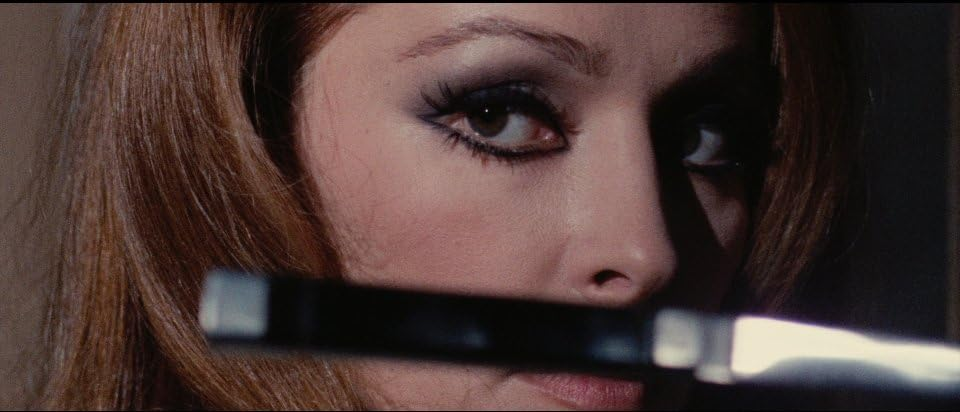
La morte accarezza a mezzanotte (1972) [ ★★★★☆ | IMDB | Wikipedia ] – Luciano Ercoli with Nieves Navarro and Simon Andreu again. Simon Andreu has a more active role in this film but with similar swagger as the previous. In the previous, he was the drunk, reckless boyfriend of the wealthy Navarro. Here, he’s a journalist boyfriend who first takes advantage of her to get a story then becomes her disbelieving confidant. This is the better movie of the two because it pairs these actors more closely. The impetus of the drama is when she takes an experimental hallucinogen and has a vision of a brutal murder. Each character she encounters is stranger than the next. Look through the IMDB photos section to get a sense of the style and mood.

La notte dei diavoli (1972) [ ★★★★☆ | IMDB | Wikipedia ] – Giorgio Ferroni. Reminiscent of the second story in I tre volti della paura. Here, A man driving through the country gets stuck when his car breaks down and so he wanders the woods and comes upon a family who offer to help him. He stays the night and is warned against going out alone because of undefined evil that roams the forest. His disbelief turns to concern for the attractive daughter whom he hopes to escape with. Though expected, the ending played out nicely.
Non si sevizia un paparino (1972) [ ★★★★★ | IMDB | Wikipedia ] – Lucio Fulci. The basic story is that an serial killer is killing young boys in a small Italian village (this time, it’s clearly late 60s/early 70s) and residents start turning on whoever the police interrogated last even after they are proven innocent. A visiting journalist and the local wealthy party girl pair up to solve the murders. Except for some dated special effects make-up, this is certainly one of the best giallo films made. And there’s somewhat of a thematic tie-in in one of its side stories with Il demonio. In both, an eccentric woman is treated as a witch and scapegoated for the ills that befall the locals, though there’s more nuance to their guilt and innocence.
Another poster I’d love to own but sadly I can only find a 4-fogli copy (55″ x 78″). Mama mia.

Il profumo della signora in nero (1974) [ ★★☆☆☆ | IMDB | Wikipedia ] – Francesco Barilli. I maybe should like this more. Woman works at a chemical factory and starts having visions of her dead mother after ominous discussions about voodoo with friends. We see at various points that many of the people she knows seem to be conspiring against her for reasons unknown. She’s presented as integral to her job and oddly disappears for days just when crucial tests and meetings are to occur, but no one seems bothered by it. The conspiracy comes together but is ultimately unsatisfying.
La polizia brancola nel buio (1975) [ ★★☆☆☆ | IMDB | Wikipedia ] – Helia Colombo. This has more style than substance (well, I guess that’s a lot of giallo) and I should like it more than I do. Some of the scenes in the cheap roadside motel and the almost excessive number of weirdos kept my interest but ultimately it felt somewhat disjointed. Very interesting trivia:
The director Helia Colombo was actually the songwriter and record producer ELIO PALUMBO (a.k.a Elio Pasquale Palumbo or simply Eliop) who is best known for “Tornerò”, a love ballad he created for the Italian pop band ‘I Santo California’, which eventually sold more than 11 million copies worldwide.
Anima persa (1977) [ ★★★☆☆ | IMDB | Wikipedia ] – Dino Risi. I categorize this with the likes of Il profumo although that was somewhere between giallo and Gothic and this is more Gothic and the tension between the characters more interesting. A nephew comes to live with his aunt and uncle–who are quite decidedly not a happy couple–to go to the nearby art school. The uncle has a psychologically abusive power over the aunt. In the attic, they keep another relative (brother?) who had gone mad after studying insects. They boy’s infatuation with the nude model at school lightens the mood of the story of this very unhealthy family.
I vizi morbosi di una governante (1977) [ ★★★☆☆ | IMDB | Wikipedia ] – A group of decadent, wealthy friends return from world travels to one of their member’s manor house. The father is approaching senility and a younger relative, locked away in a basement cell performing taxydermy on various animals, is mute and trouble ever since he watched his mother get murdered years ago. After one of their group is murdered (with her eyes removed with taxidermy-like precision) the classic giallo inspector appears: older, slightly overweight, cigar, calm confidence that the case will be solved (as seen in both Ercoli’s La morete movies).
Our various commissari:
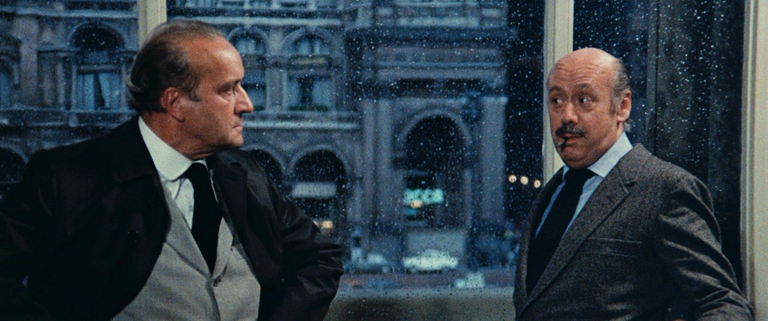

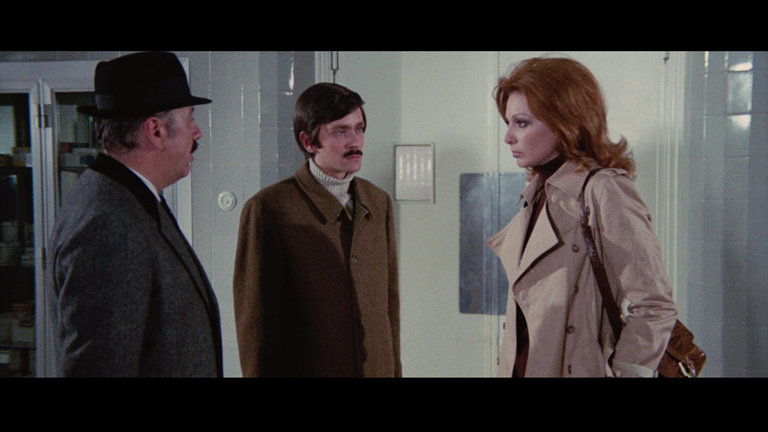
La sorella di Ursula (1978) [ ★★☆☆☆ | IMDB | Wikipedia ] – Enzo Milioni. Although one of the leads–Barbara Magnolfi–was rather striking and I’m sure has better roles in other films (in Suspiria for one), unfortunately this film just wandered and for a good part of it came pretty close to pornography. Magnolfi was not satisfied with that aspect either, from IMDB trivia:
Actress Barbara Magnolfi has expressed her disappointment in the final version of the film. She stated she was disappointed that they changed the film from a more serious psychological thriller to more of an erotic thriller.
There was a good classic giallo story with aspects of the supernatural to be had but it defeats itself with extended, inelegant sex scenes. Sisters arrive at a resort and their mood suggests a recent, disturbing event in their past. Guests and others in the vicinity of the hotel start being murdered and the younger sister, Magnolfi, has visions that their father is the murderer.
